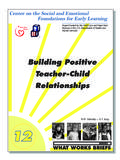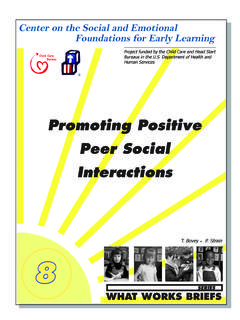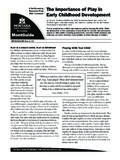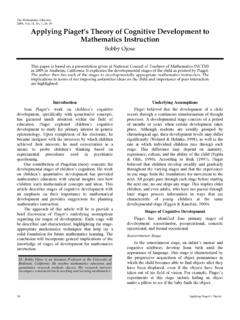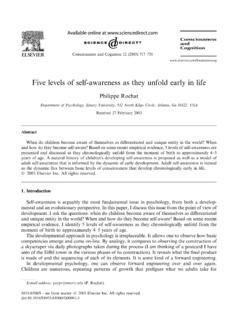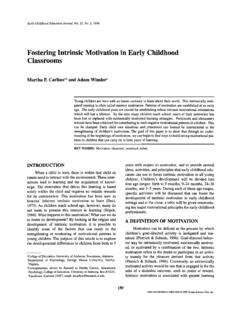Transcription of HealtHy Beginnings
1 Division of Early ChilDhooD DEvElopmEntOffice Of child careH e a l t H yB e g i n n i n g s : Supporting Development and Learning from Birth through Three Years of Baby, Every ChildJames H. DeGraffenreidt, , Maryland State Board of EducationDr. Nancy S. GrasmickSecretary/Treasurer of the BoardState Superintendent of SchoolsRolf GrafwallnerAssistant State SuperintendentDivision of Early Childhood DevelopmentMartin O MalleyGovernorThe Maryland State Department of Education does not discriminate on the basis of race, color, sex, age, national origin, religion, disability, or sexual ori-entation in matters affecting employment or in providing access to programs. For inquiries related to Department policy, please contact: Equity Assurance and Compliance OfficeOffice of the Deputy State Superintendent for AdministrationMaryland State Department of Education200 W. Baltimore Street - 6th FloorBaltimore, Maryland 21201-2595410-767-0433 - voice410-767-0431 - fax410-333-6442 - TTY/TDDFor more information about this publication, contact 410-767-0335 2010 Maryland State Department of EducationWe would like to thank the following members of our national panel of expert reviewers:Melinda Brookshire: Senior Program Associate, WestEd Center for Child and Family LearningDr.
2 Carol Copple: Director, Publications and Initiatives in Educational Practice, National Association for the Education of Young children (NAEYC)Kim Cosgrove: Program Director, PACT s Therapeutic NurseriesAmy Dombro: Author, Creative CurriculumDr. Charles Flatter: Professor Emeritus, The Institute for Child Study, University of MarylandLinda Gillespie: Technical Assistance Manager, National Infant Toddler Child Care Initiative, Zero to ThreeWhit Hayslip: Assistant Superintendent for Early Childhood Education, Los Angeles Unified School DistrictCarole Norris-Shortle: Clinical Assistant Professor, University of Maryland School of MedicineDr. Jane Squires: Professor, College of Education; Director, Center on Human Development; Director, Early Intervention Program, University of Oregon Dr. Bonnie Tyler: The Institute for Child Study, University of MarylandWe would like to thank the following individuals for their participation on the MSDE Curriculum Advisory Committee:Lindi Mitchell Budd, : Maryland State Department of Education, Office of Child CareFrancesca Carpenter, : Project Manager, Johns Hopkins University Center for Technology in EducationMichael Cockey: Maryland State Department of Education, Early Learning SpecialistLouise J.
3 Corwin: Executive Director, Ready At FiveDonna Fowler: Director of Public Policy, Maryland State Family Child Care AssociationMarcella Franczkowski: Maryland State Department of Education, Branch Chief/Program Manager, Early Childhood and Intervention BranchRobin L Hopkins, Ed.: Project Manager/Instructor, Johns Hopkins University Center for Technology in EducationElizabeth Kelley, : Maryland State Department of Education-Division of Early Childhood Education, Director, Office of Child Care Rosemary King Johnston: Executive Director, Governor s Office for ChildrenJennifer A. Nizer, : Director, Johns Hopkins Bayview Child Development AcknowledgementsThe Guidelines were originally produced by theOffice of Child Care while under the Departmentof Human Resources with financial support fromThe Maryland State Department of Education. We would like to thank the following individuals for participating in the development of the original Guidelines as part of the Good Start, Grow Smart Arnaiz: Montgomery County Child Care Resource & Referral CenterMiriam Baldwin: Instituto de Educacion InfantilLinda Behsudi: Howard County Child Care Resource CenterLouise Corwin: Ready at FiveDr.
4 Rolf Grafwallner: Maryland State Department of Education, Early Learning SectionDorothy Hale: Child Care Administration Office of Program DevelopmentLeslie Hamm: Montgomery County Early Childhood OfficeTresa Hanna: Baltimore City Child Care Resource CenterDolores Harmon: Child Care Administration, Region 7 - Western MarylandCatherine Howanstine: Teacher, Facilitator, WriterCecilia Johnson: Trainer Baltimore CityValerie Kaufmann: Maryland State Department of Education, Judy Center CoordinatorElizabeth Kelley: Child Care Administration Office of CredentialingKaren Kerber: Center Director Montgomery CountyKaren Knabe: Family Child Care Association Howard County/StateBeverly Knight: Friends of the FamilyBarbara McCready: Child Care Administration, Region 6 Howard CountyDebbie Metzger: Maryland State Department of Education, Special EducationJean Mitchell: Friends of the FamilyMary Montgomery: Community Partnership Manager Washington CountyDebbie Moore: Family Child Care AdvocateJoyce Nixon: Maryland State Department of Education, Accreditation ProjectCathy Perry: Judith P.
5 Hoyer Center - Frederick CountySteve Rohde: Maryland Committee for ChildrenPat Rosensteel: Head Start, Child Care - Frederick CountyAnnette Searfoss: APPLES for ChildrenClare Siegel: Friends of the FamilyMargo Sipes: Center Director Baltimore CityDebbie Slack-Katz: Governor s Office for children , Youth & Families, Home VisitingGinny Smith: Harford County Public SchoolsBarbara L. Tayman: National Child Care Information CenterCecelia Tilghman: Child Care Administration Office of CredentialingLinda Zang: Maryland State Department of Education, Head StartCenter; President, Maryland State Child Care Association Jacqueline A. Nunn, Ed. D.: Director, Johns Hopkins University Center for Technology in Education; Associate Dean, Johns Hopkins University School of EducationTamara Swanson Otto: Coordinator, Research and Evaluation, JohnsHopkins University Center for Technology in EducationJoyce Pinkney, Ed. D.: Maryland State Department of Education-Division of Early Childhood EducationSteve Rohde: Deputy Director Resource and Referral Services, Maryland Family NetworkDr.
6 Barbara Payne Shelton: Consultant, Early Childhood Educational Consultants, LLC; Adjunct Instructor, Towson UniversityMargo Sipes: Executive Director, Downtown Baltimore Child CareJena Valle Smith: Maryland State Department of Education-Credentialing Branch, Training Approval Coordinator Office of Child Care Chris Swanson: Director of Early Childhood Initiatives, Johns Hopkins University Center for Technology in EducationNancy Vorobey: Maryland State Department of Education, Section Chief, Early Childhood Intervention & Education BranchLinda Zang: Maryland State Department of Education, Chief, Collaboration and Program Improvement BranchPhilosophy Statement ..PAGE ivGuidelines: Birth to Four Months ..PAGE 1 Four to Eight Months ..PAGE 4 Eight to Twelve Months ..PAGE 8 Twelve to Eighteen Months ..PAGE 12 Eighteen to Twenty-Four Months ..PAGE 18 Twenty-Four to Thirty Months ..PAGE 25 Thirty Months to Three Years.
7 PAGE 33 Three Years Old ..PAGE 42 Appendix Glossary of Terms Used ..PAGE 54 Resource List ..PAGE 55 Resources Used ..PAGE 56 Using HealtHy Beginnings :Supporting Development and Learning from Birth through Three Years of AgeHealthy Beginnings : Supporting Development and Learning from Birth through Three Years of Age is intended for use by anyone who lives or works with infants or young children . The guidelines can be used as a reference guide, or as a resource for planning daily or weekly activities. Use the guidelines by first locating the child s age in months and choosing a developmental area. Use the Indicators (The baby may) to identify Activities (You can) that will support the child in meeting that indicator. Use the Examples (The baby might) to deter-mine if the child has met that indicator. You can also determine a starting point by identifying behaviors or actions that a child is already displaying.
8 Once you ve identified those behaviors or actions, use the Activities and Examples to develop plans that support the child s progress to the next Indicator. In this way, you can support learning through the Indicators regardless of the child s chronological in mind that not all children develop at the same rate, so the age ranges should be used as suggestions. Caregivers can and should plan activities that meet the needs of each particular child in their care. Addition-ally, everyone involved in a child s care should communicate daily about the child s activities, interests, and development, maintaining open communication and being sensitive to the child s and family s e a l t H y B e g i n n i n g s :Supporting Development and Learning from Birth through Three Years of AgeTable of ContentsPublication Date: November, 20102004 - Originally published as: The Guidelines for HealtHy Child Development and Care for Young children (Birth - Three Years of Age)2007 - Guidelines were updatedChildren are born with tremendous potential and capacity for learning across all developmental domains: physical, cognitive, emotional, language, and social development.
9 Brain development in early childhood is influenced by heredity, experiences, and relationships. The adults who live with and care for infants and young children play an important role in laying the foundation and setting the stage for learning success. This set of developmental and learning guidelines was developed to ensure that the people who care for infants and young children have the knowledge and resources to support and encourage children during the ongoing process of growth and learning. These guidelines will help those living or working with young children to recognize appropriate behaviors and set realistic expectations for infant, toddler, and preschooler growth, development, and learning. The Guidelines for HealtHy Child Development and Care for Young children (Birth - Three Years of Age) was originally compiled in 2004 by a workgroup composed of early childhood professionals, to be compatible with the Maryland Model for School Readiness (MMSR) and the Maryland State Curriculum, making the guidelines an important part of a Birth-Grade 12 learning continuum.
10 The guidelines also met the expectations of the No Child Left Behind Act, National Association for the Education of Young children (NAEYC), and the National Association of Early Childhood Specialists in State Departments of Education (NAECS/SDE), which were stated in a joint posi-tion paper of November 2002. The Guidelines were updated in 2007. Early learning guidelines can be a valuable part of a comprehensive high quality system of services for young children , contributing to young children s educational experiences and to their future success. But these results can be achieved only if the early learning standards (1) emphasize significant, developmentally appropriate content and outcomes; (2) are developed and reviewed through informed, inclusive processes; (3) use implementation and assessment strategies that are ethical and appropriate for young children ; and (4) are accompanied by strong supports for early childhood programs, professionals, and 2009, the Maryland State Department of Education Division of Early Childhood Development began a revision of these guidelines and changed the name to HealtHy Beginnings : Supporting Development and Learning from Birth through Three Years of Age.




